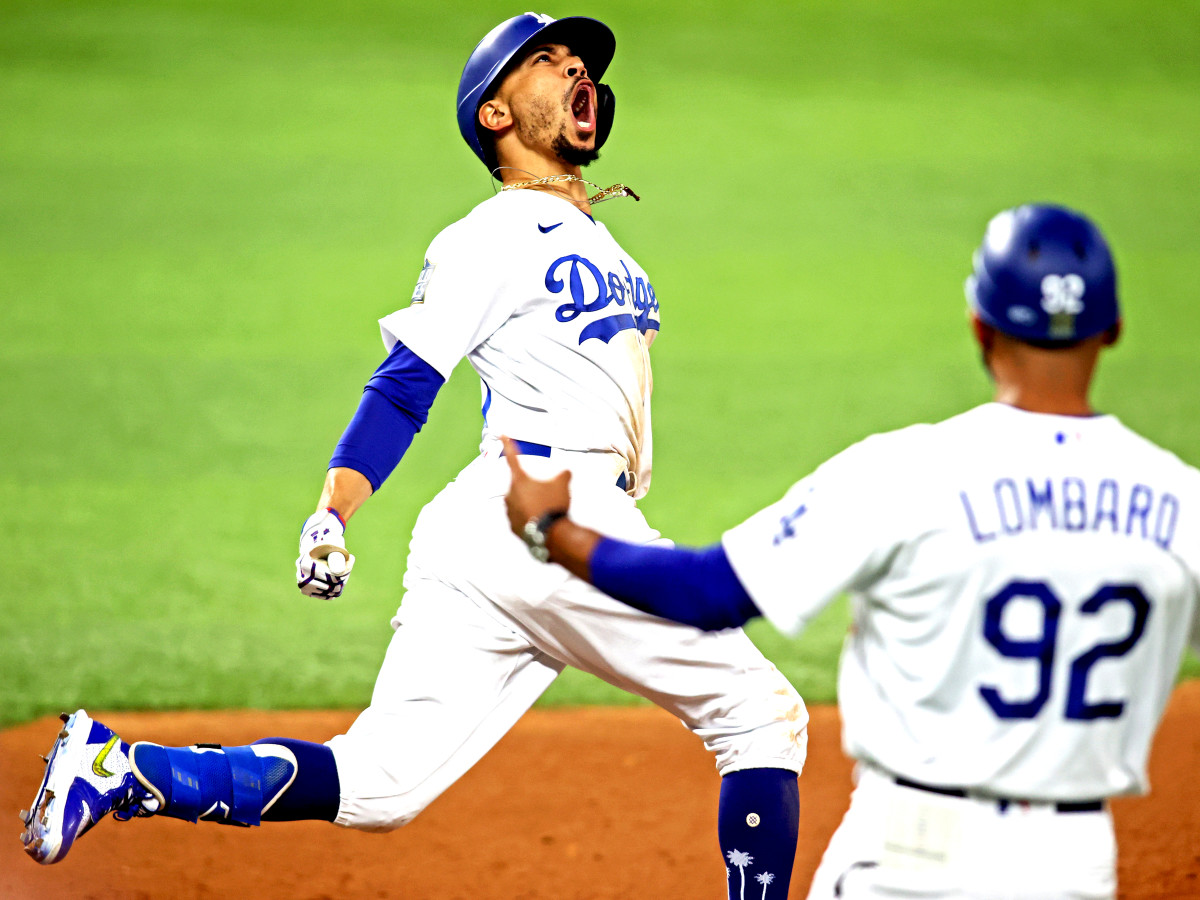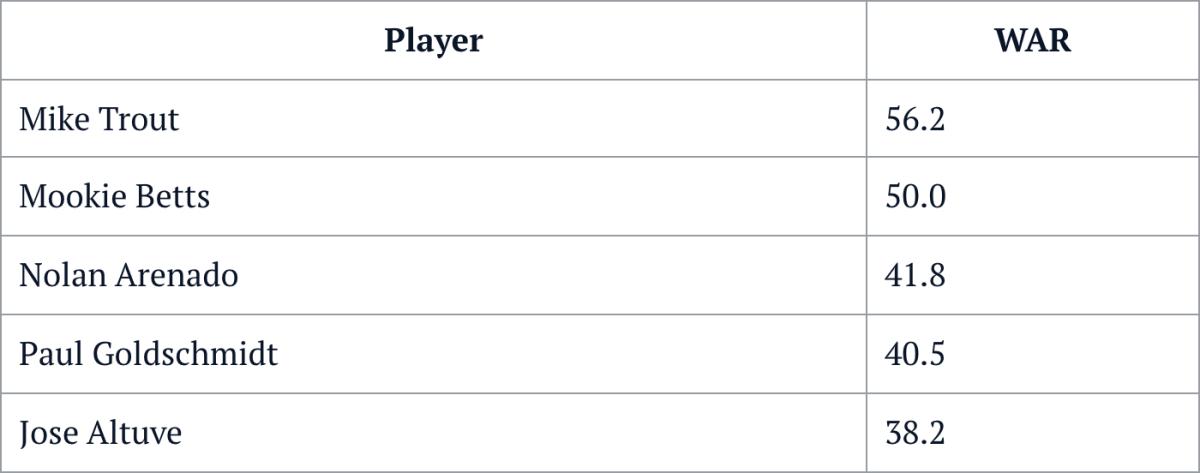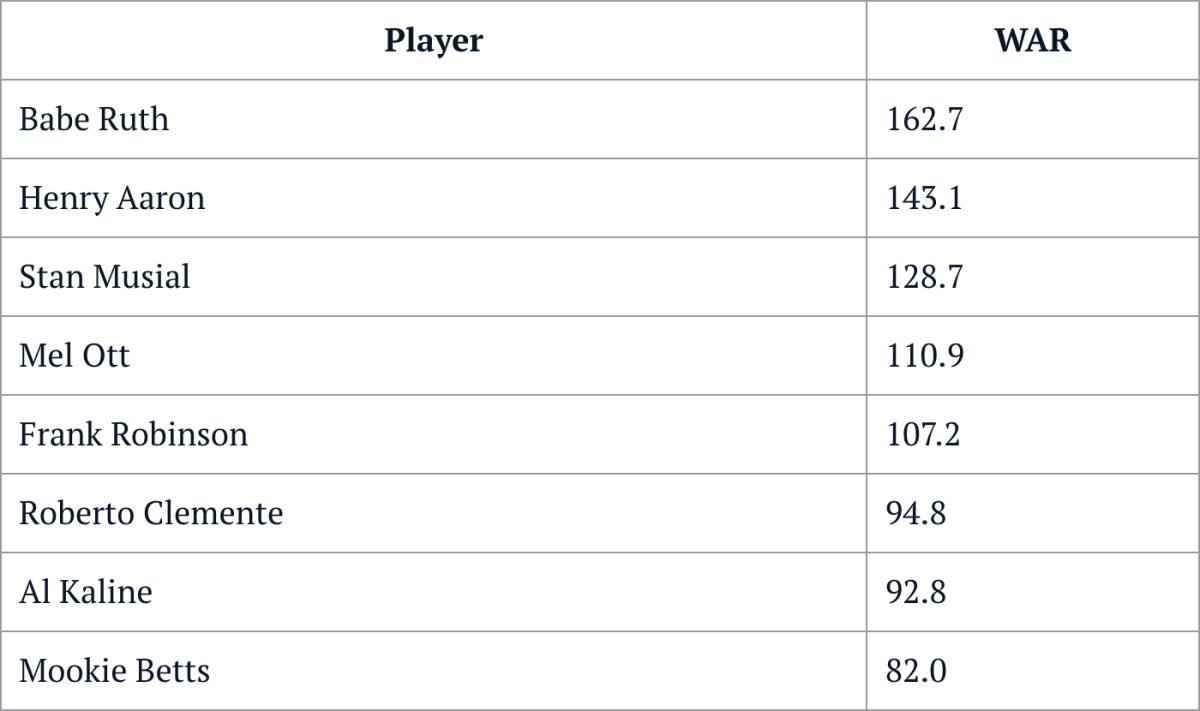Is Mookie Betts Already a Hall of Famer?

The Hall of Fame is going to have to carry us through the lockout. We’ll get a ton of discourse about the players on the 2022 BBWAA ballot with Barry Bonds, Roger Clemens, Curt Schilling and Sammy Sosa in their final years of eligibility and Alex Rodriguez and David Ortiz in their first. We’ll also see breakdowns about the various veterans-committee elections, the most recent two naming six new Hall of Famers.
What can get lost in the ether of HOF conversations, though, are the current players. Typically, we talk about them during the season, as aging stars reach milestones or announce their farewell tours. We rarely get into the debate when it comes to players with less than 10 years of service time, which makes sense, given that one of the factors HOF voters consider is a candidate’s longevity.

Even so, there are rare instances when players rack up accomplishments early enough to warrant such discussions. Eight years into his career, Mookie Betts has an interesting Hall of Fame case. Indeed, unless he has a sharper decline than Andruw Jones, or stops playing altogether before he reaches the 10-year threshold, Betts already has had an HOF-worthy career.
The most general argument in his favor is this: Mike Trout is the best player of this era; Betts is the second best, and it’s not even close.
Position Players Since 2014, WAR

Betts has won two World Series titles, an MVP award, a batting title, five Gold Gloves and four Silver Sluggers. A five-time All-Star, he’s only 29 years old and is signed with the Dodgers through 2032, his age-39 season. He could easily double all of these accolades by the time that deal is up.
Here are Betts’s career numbers through his first eight seasons, along with the average career numbers for the 28 Hall of Fame right fielders:

First, it makes sense that Betts is below the average HOF right fielder for career WAR, considering he’s played only eight seasons and WAR is a cumulative stat. That’s expected. The average career length of the 28 HOF right fielders is 18 seasons. And yet, his 50.0 WAR is more than eight HOF right fielders, including two recent inductees of the veterans committee, Tony Oliva (43.0) and Harold Baines (38.7).
What’s telling here is that WAR/7 figure, which is the total WAR a player accumulated in his seven best seasons. For Betts, his WAR/7 includes the sum of his WAR for all but his rookie season, in which he was called up in late June and played in just 52 games. So, even if Betts never has another season with more WAR than the 3.6 he had in 2020, his WAR/7 would still be better than the average Hall of Fame right fielder.
His seven-year peak isn’t just better than the average enshrinee; it’s the best of any right fielder who has debuted in the last six decades. His 47.7 WAR/7 is good for ninth-best all-time among right fielders, with Shoeless Joe Jackson being the only non-HOF member ahead of Betts.
The real question for Betts is not whether he gets into the Hall of Fame, but where he ranks among the best right fielders in Cooperstown when he makes it.
It’s worth noting here that Betts played 55 games in the 60-game 2020 campaign. Over a full-length season, that works out to a pace of 148 games and 9.7 WAR. We’ll call this his adjusted '20 season, an approximation for what Betts would have done had the COVID-19 pandemic not delayed the year.
Betts’s adjusted 2020 season: 148 G, 662 PA, 589 AB, 172 H, 43 HR, 126 R, 105 RBI, 27 SB, 9.7 WAR
We can plug in his adjusted 2020 season with his numbers from 2015 to '19 and '21 to estimate the average full-length year for Betts.
Betts’s average full-length season: 145 G, 661 PA, 581 AB, 172 H, 29 HR, 114 R, 88 RBI, 22 SB, 7.7 WAR
Now, let’s say Betts maintains this average production over the next four years, covering his age-29–32 seasons. These would be his numbers 12 years into his MLB career.

At this point, Betts would still have another seven years left on that 12-year, $365 million extension he signed with the Dodgers, assuming he doesn’t retire before the end of it.
We can’t expect he’ll continue to produce at that same full-season level during the back part of that deal. Without getting too in the weeds, let’s try to account for his steady decline over the final third of his career.
Back when the Red Sox were looking to trade Betts in early 2020, and then once again when the Dodgers extended him after acquiring him from Boston, Tom Verducci wrote about how hard it is to project how well Betts would age because there are so few players like him. He’s listed at 5' 9" and 180 pounds, and as Verducci notes, the only comp for Betts—as a small power hitter—is Hall of Fame right fielder Mel Ott, who debuted 95 years ago.
It’s true the game has changed tremendously since Ott’s days, so comparing them is far from an exact science. Even so, let’s use Ott as a rough sketch for what the final years of Betts could look like. This won’t quite line up, because Ott was 19 for his first full season, while Betts was 22. Because we’re using this to see how the aging curve might work for a small power hitter, we'll match the ages. I’ll use Betts’s adjusted 2020 season instead of his actual one so that his numbers are more representative of his performance.
Ages 22–28

That’s pretty close. Ott was the better hitter, while Betts got the boost in WAR from his superior defense and baserunning.
Ott was 36 in his last full season, and from ages 29 to 36, he tallied 44.9 WAR (5.6 per year) and hit 204 more home runs (26 per year). If Betts follows a similar progression, averaging, say 24 homers and 6.3 WAR—that's two fewer homers, 1.4 fewer WAR—here are what his career numbers would be through his age-36 season.

Let’s be clear: I’m not saying Betts is going to be a 100-WAR player. That’s a ridiculous prediction for anyone; only 20 position players have finished their careers with as many WAR. But even if Betts averages 4.0 WAR over the next eight years and then is roughly replacement level over the final three years of his megadeal, he’d finish his career with 82 WAR. If that more conservative projection plays out, Betts would be eighth all-time among primary right fielders, and by far the best since Henry Aaron and Frank Robinson both retired in 1976.

The point of this exercise is not to show that Betts is the next Mel Ott (he’s not), or that this Martell guy is nuts (I am, but not for this reason). It’s not even that Baseball-Reference considers Stan Musial a right fielder despite playing more games at first base (1,016) and left field (929) than he did in right (783).
The key takeaway is this: Betts is eight years into a Hall of Fame career that isn’t yet halfway through. Whenever the labor dispute ends and a new season begins, we’ll once again get to appreciate the greatness of the best right fielder in a half century. Now that’s something to cling to as we endure these weeks, and quite possibly months, of MLB’s lockout.
MAILBAG ALERT: Emma Baccellieri will be answering your questions in next week’s newsletter. Send them to mlb@si.com with the subject line “Ask Emma” no later than Thursday, Dec. 16.
As always, if you have any other questions or comments for our team, you can send us a note.
1. THE OPENER
“Since the league locked out the players when the collective bargaining agreement expired at 11:59 p.m. on Dec. 1, team websites yanked down articles about current players and scrubbed their headshots from rosters. … Whether this is about avoiding a grievance or sending a message, the fact remains that the league has erased the players. The players should write themselves back into the story.”
That’s Stephanie Apstein, writing in her column today about the relative silence so far during the lockout from the players. She recommends that the union “should schedule daily Zooms in which players explain to fans, through reporters, why they believe the game’s economy is broken.”
The lockout isn't only a battle between millionaires and billionaires, Stephanie says. It's time for the players to explain how the league has failed them.
Read Stephanie’s entire column here.
2. ICYMI
Didn’t get a chance to read our coverage of Sunday’s Hall of Fame election? You can get caught up here.
Remembering the Fame of the Baseball Hall by Tom Verducci
The oversight committees correct the record in electing six new inductees, four of whom were chosen for their worthy hybrid careers.
Gil Hodges Belongs in the Hall of Fame by Tom Verducci
After all the years and all the near misses, the HOF finally got it right. He is deserving not because of his playing career or his managing career but because of both.
This week in nonlockout baseball columns ...
Braves Risk Wasting a Ready-Made Repeat Opportunity by Will Laws
The World Series champions have some major roster holes to fill this offseason.
Why Aren't the Yankees Acting Like the Yankees? by Nick Selbe
New York used to instill fear in the hearts of opposing front offices for its ability to outspend the competition. But the Yanks have been downright stingy this offseason.
3. WORTH NOTING by Stephanie Apstein
Only players on 40-man rosters are represented by the union, which means only they are locked out, which means teams can proceed normally with minor leaguers right now. The minor league portion of the Rule 5 draft took place as scheduled this week, and at least 10 teams have signed players to minor league deals since the lockout began. One thing we haven’t seen yet, though, is a trade of prospects. Those swaps, when they involve top prospects, are often known as “challenge trades”: Basically, each side believes it is better at evaluating players. (One of the most famous examples of a challenge trade came in 2012, when the Yankees sent catcher Jesús Montero, then the No. 6 prospect in the game, to the Mariners for righty Michael Pineda, who was a year removed from being No. 16. Neither player became the star he was expected to be, but Pineda gave his new team 509 league-average innings in four years.) We have seen fewer of these deals in recent years, but as the lockout drags on and team executives get antsy, maybe we will see a few more of them.
4. TRIVIA! from Matt Martell
There are 22 position players in MLB history that accumulated at least 50 WAR over their first eight seasons. Mookie Betts is one of the four players in this group who are not in the Hall of Fame. Can you name the other three?
5. THE CLOSER from Emma Baccellieri
Let’s briefly revive an old SI staple, “Sign of the Apocalypse”:
New York Times crossword puzzle aficionados are accustomed to seeing “A-Rod” clued as “Yankees slugger” or something of the like. (And he shows up with some frequency: It’s a useful combination of letters!) But his clue this week held no mention of baseball.
As 38 down on Wednesday: “J.Lo’s one-time beau.”
That’s all from us today. We’ll be back in your inbox next Friday. In the meantime, share this newsletter with your friends and family, and tell them to sign up at SI.com/newsletters. If you have any questions or comments, shoot us an email at mlb@si.com.
